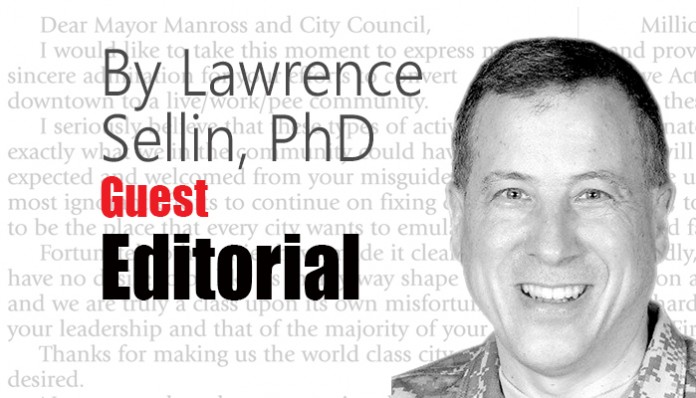The answer is exemplified by the 1980 to 1988 Iran-Iraq War, where we allow, even encourage, the fanatics to kill each other, given their seemingly insatiable appetite for internecine warfare, preferably, without an American presence.
It is a foreign policy based, not on altruism or quaint notions of “breaking the cycle of violence,” but on leveraging the chaos.
That is, the U.S. should begin a transition from policies relying on military intervention to strategically disrupting the plans of our adversaries by exploiting the instability of which the U.S. itself has often been the victim.
Even without the Islamic State, the Middle East remains an epicenter of Islamic extremism and a complex political-military environment dominated by the Sunni-Shia religious conflict, but also influenced by ethnic aspirations, tribal rivalries, regional hegemony, superpower competition and ever-shifting allegiances.
We must disabuse ourselves of the expectation that there is some yet unidentified grand design, a one-size-fits-all strategy to defend our national interests.
In a region with a chronic level of instability, of ambiguities and animosities, we have no permanent friends or enemies and need to reexamine our relationships on a continual basis, including using the mutually destructive behaviors among opponents for our short- or long-term advantage.
A heathy first step in transitioning to a more rational and practical foreign policy is to admit that the War on Terror is over and the methods we used to fight it are obsolete.
We didn’t lose that fight, but we haven’t exactly won either. A further pursuit of stalemate would be an unnecessary, even tragic forfeiture of blood and treasure, which would not honor our dead and wounded, while producing more of the same.
The War on Terror itself is a misnomer. Islamic extremism is largely driven by nation states and is simply the latest iteration of proxy warfare. Iran uses it against the U.S. and Israel. Pakistan uses it against Afghanistan and India. Turkey uses it against Syria. Saudi Arabia funds it to promote a fundamentalist strain of Islam known as Wahhabism in order to establish a global caliphate.
The export of Wahhabism is clearly contrary to the interests of the United States, yet Saudi Arabia remains an “ally,” no doubt influenced by Saudi contributions across the American political spectrum. In the battle against Islamic extremism, the U.S. cannot continue its role as global firefighter while supporting the arsonist.
The two foremost promoters of Islamic extremism, Saudi Arabia and Iran, now find themselves leading the Sunni-Shia contest for theological hegemony and fighting a mini Iran-Iraq War for regional political-military dominance via proxies in Yemen.
Strategic disruption would allow the U.S. to withdraw from Afghanistan while protecting our national interests by shifting the burden of the instability onto adversaries with regional ambitions.
Pakistan has never been an ally of the United States, but a duplicitous partner, pursuing its own interests in coordination with its true ally, China. While accepting billions of American dollars in military and economic aid, Pakistan has been slowly bleeding the U.S. to death in Afghanistan through its support of the Taliban, Haqqani Network and other terrorist groups.
The U.S. presence has always been an obstacle to Chinese ambitions to incorporate Afghanistan into Beijing’s Belt and Road Initiative as well as a number of other China-centric economic & military pacts, so, together with Pakistan, China could dominate South Asia.
China’s eventual aim is to expand its military footprint by establishing military bases on Pakistan’s Arabian Sea coast close to the Strait of Hormuz, the chokepoint for the oil leaving the Persian Gulf. Those bases would provide a critical link between China’s military facilities in the South China Sea and its naval base in Djibouti at the entrance of the Red Sea and the Suez Canal.
The Chinese plan is dependent of the success of the China-Pakistan Economic Corridor, the flagship of its Belt and Road Initiative and highly susceptible to the same instability Pakistan has stoked to prevent the U.S. from achieving its goals in Afghanistan.
In a similar way, instead of being a victim of them, the U.S. could strategically disrupt Russian or Iranian ambitions in the Middle East by leveraging the chaos or exploiting the fault lines from a variety of historic enmities; the Sunni-Shia conflict, the struggle for Kurdish and Baloch independence or the competition between secular and religious elements.
It’s not rocket science. It’s Machiavelli.
Lawrence Sellin, Ph.D. is a retired US Army Reserve colonel, trained in Arabic and Kurdish, an IT command and control and cyber security subject matter expert and a veteran of Afghanistan, Iraq and Africa. He receives email at [email protected] and can be followed on Twitter @LawrenceSellin.





